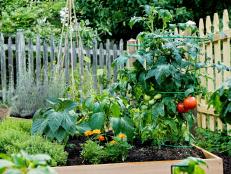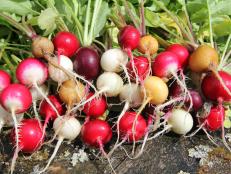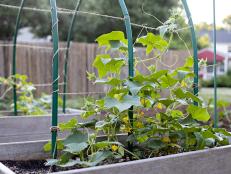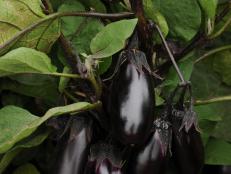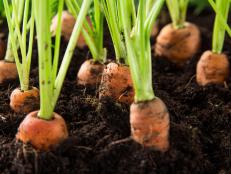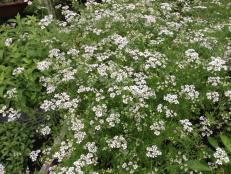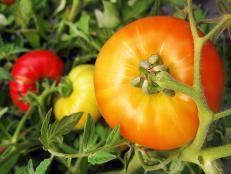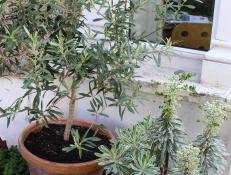Getting the Most Out of Vegetable Gardens
These tips will teach you how to reap bigger, better and more plentiful produce.

Debbie Wolfe
Everyone who plants a vegetable garden wants to enjoy as much yield as possible from it. Here, in no particular order, are some tried-and-true planting methods that have proven successful to master gardener Paul James. A few of them might work for you to produce stronger, more bountiful plants.
Thinning Plants
Thinning is a process that often applies to crops whose seeds are so small that it's difficult to space them properly at planting time, whether they're sown in straight or wide rows. As a result, vegetables like lettuce and other greens, carrots and turnips often wind up being planted too thickly. Too many plants in a space will mean not enough moisture and nutrients to go around. By thinning them to the proper distance between plants as indicated on the seed packet or planting guide (that is, by gently pulling out the extras when they're young), there'll be enough food and water for the plants that remain. When you've finished, apply a little fertilizer and water well to perk up the remaining plants.
Succession Planting
Succession planting is a good way to increase and extend the harvest of various crops. In the case of lettuce, for instance, you can sow a small bed of red butterhead lettuce and in two weeks the plants have come up. In another couple of weeks, the lettuce will be ready to pick. Instead of sowing all your seed at the same time, stagger the plantings at two-week intervals to avoid any gaps or abrupt halts in production or consumption. If the weather doesn't get too hot or too cold, you may be able to get in a third crop and maybe even a fourth. Succession planting works best with quick-growing crops that are ready to harvest within 60 days when sown from seed. Greens, radishes, carrots, turnips, squash, beans and cucumbers are just a few good candidates.
Interplanting
What if you've filled every square inch of soil with spring vegetables and have no room for your summer vegetables? Try a technique known as interplanting. Here's how it works:
A bed of onions may not be ready to harvest for several weeks, but by selectively pulling a few tender scallions early, you can make room for a young tomato, pepper or eggplant. The onions will continue to grow to maturity while the tomato develops, and two crops can be harvested from the same bed. Another good combination for interplanting is cantaloupe and corn. On either side of a raised bed, sow a row of corn down the full length of the bed. Between the rows, sow a few hills of cantaloupe, spacing the hills roughly three feet apart. Since corn grows straight up without casting much shade and cantaloupe hugs the ground, you can get two crops out of the same bed.
Inoculating Plants
One of the simplest and least expensive ways to increase production of peas, beans and other legumes is to inoculate them with a shot of bacteria. These plants get the bulk of their nitrogen from the air rather than the soil, thanks to beneficial bacteria that live in little nodules on the plant's roots. If the bacteria are not present in your soil, you need to add it at planting time. The inoculate is available by mail or from most nurseries and home and garden centers. To use, simply put your pea or bean seeds in a container, pour in a little bit of water and add the powdered inoculate. Mix everything together so that each seed gets a nice coating. Now plant the seeds as usual.
Hilling Potatoes
To increase your potato harvest by at least 25 percent, try hilling them. Simply add a two- to four-inch layer of compost or soil to the planting bed or draw soil into the bed with a hoe. The idea is to create new space for developing tubers, which tend to grow in the top four to eight inches of soil. Continue hilling every few weeks, whenever six inches or so of top growth has re-emerged. Once the plants flower, that is your cue to stop the process and let the potatoes develop fully.
Tomato Planting Tips
The standard way to plant a typical tomato transplant is to dig a shallow hole and drop the plant into it. If you look closely at a tomato stem, however, you'll see hundreds of little white hairs, each one of which is a potential root. Because having more roots generally means a more vigorous plant, why not take advantage of the tomato's unique ability to produce roots so easily? One way to do that is to plant the tomato in a trench on its side. This may look strange at first, but soon the plant will begin to grow straight up, and hundreds of little roots will grow out into the surrounding soil. Another way to encourage new-root growth is to bury the plant. With scissors, remove all but the top set or two of leaves from the transplant, then dig a deep hole and bury the plant up to those leaves.






